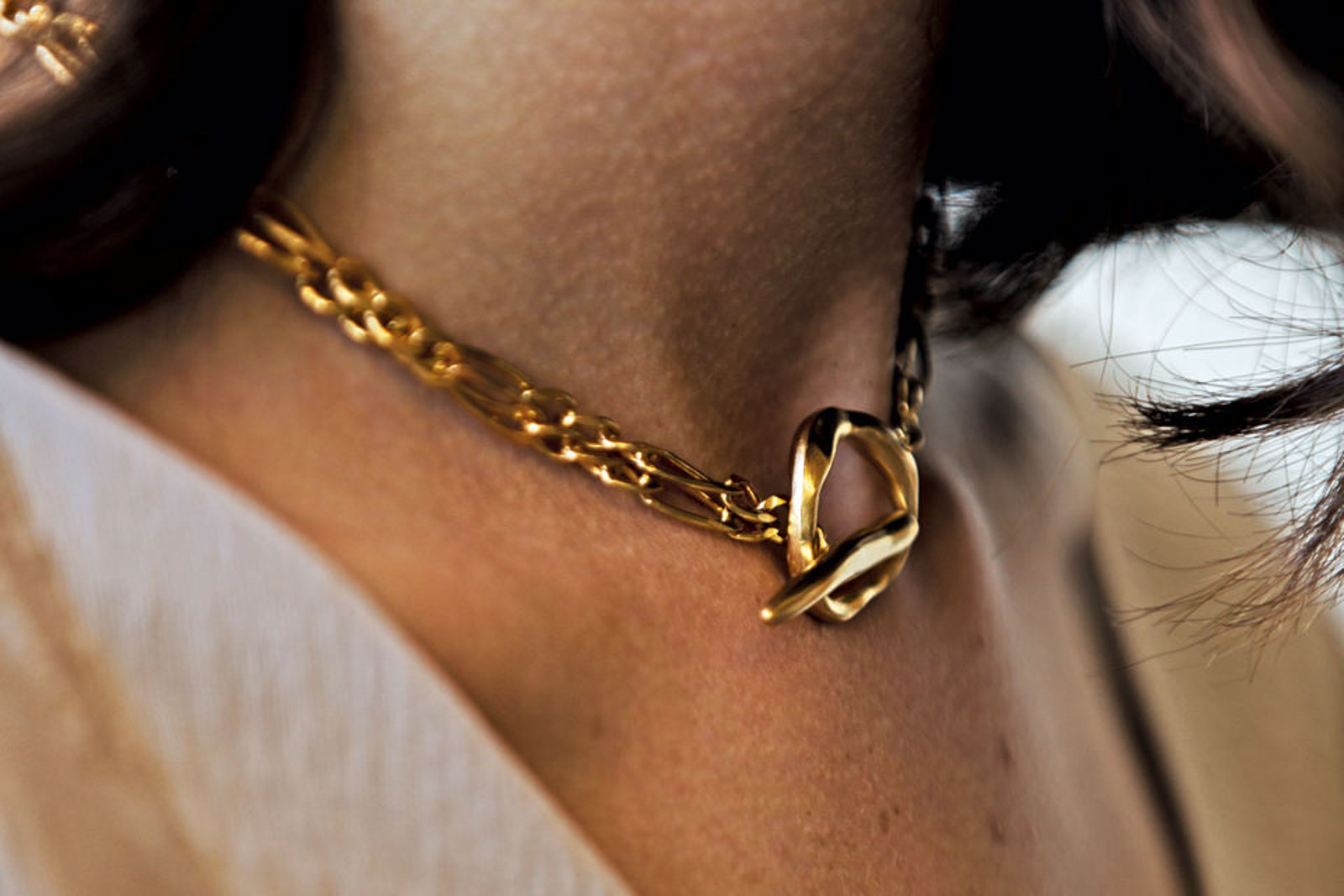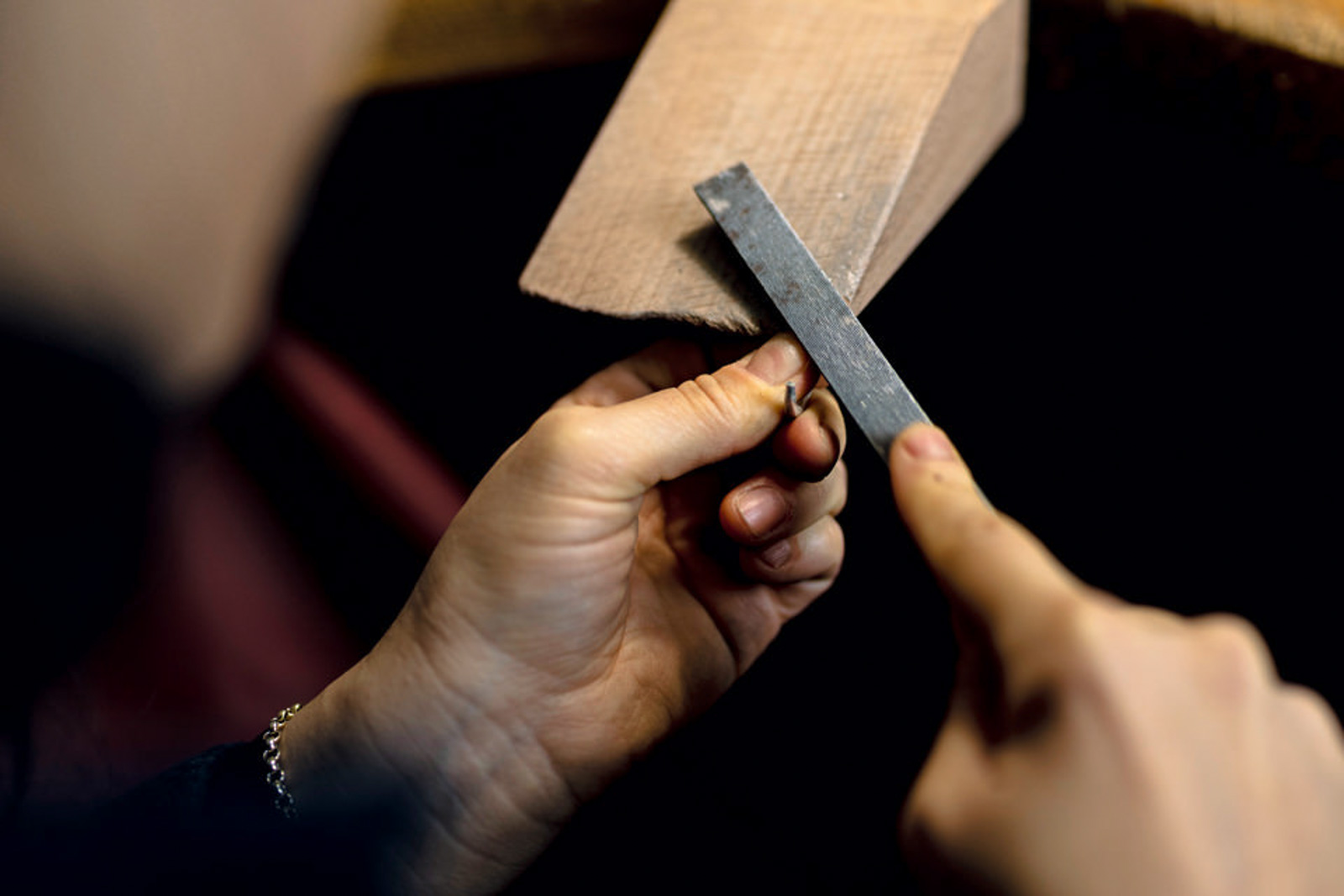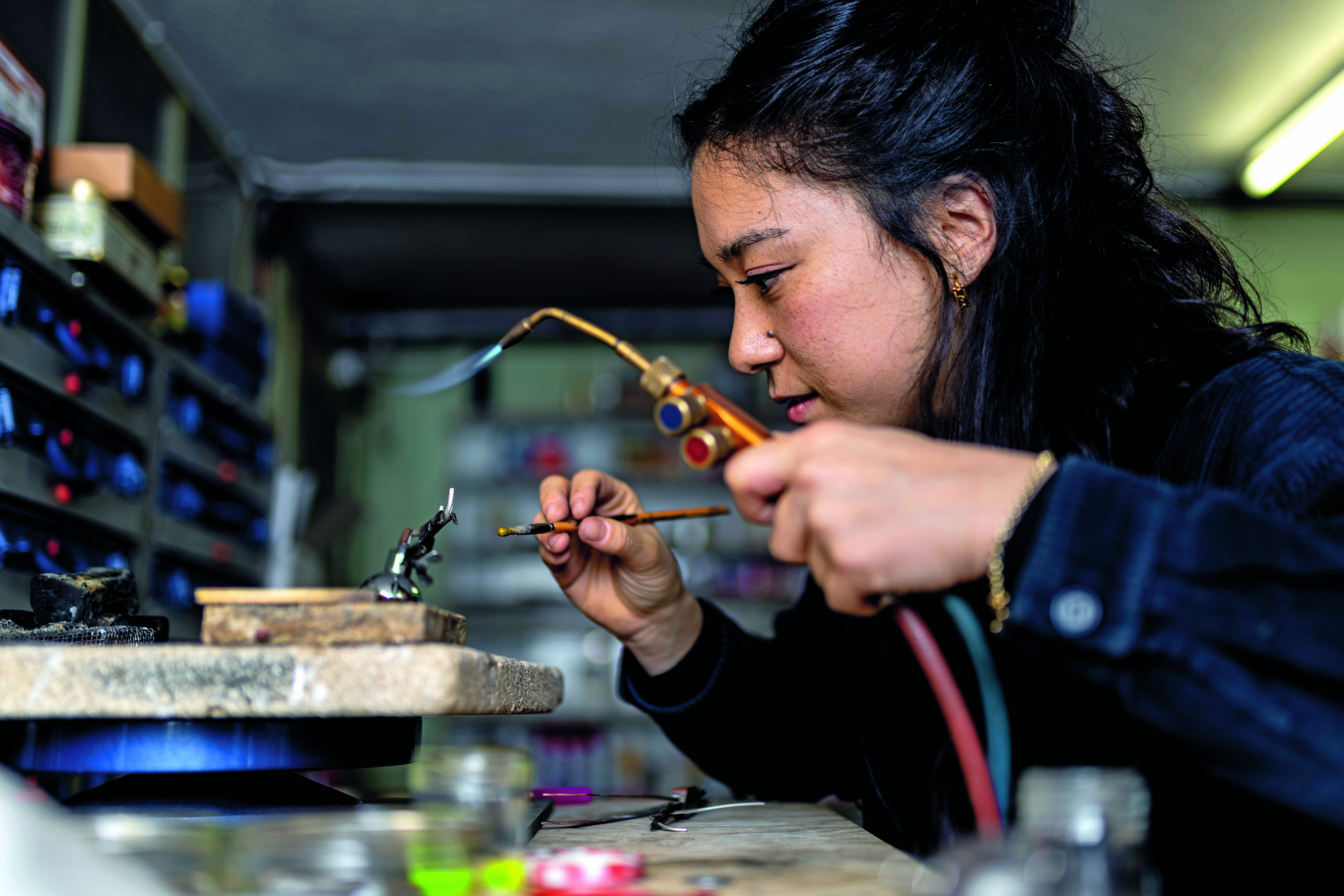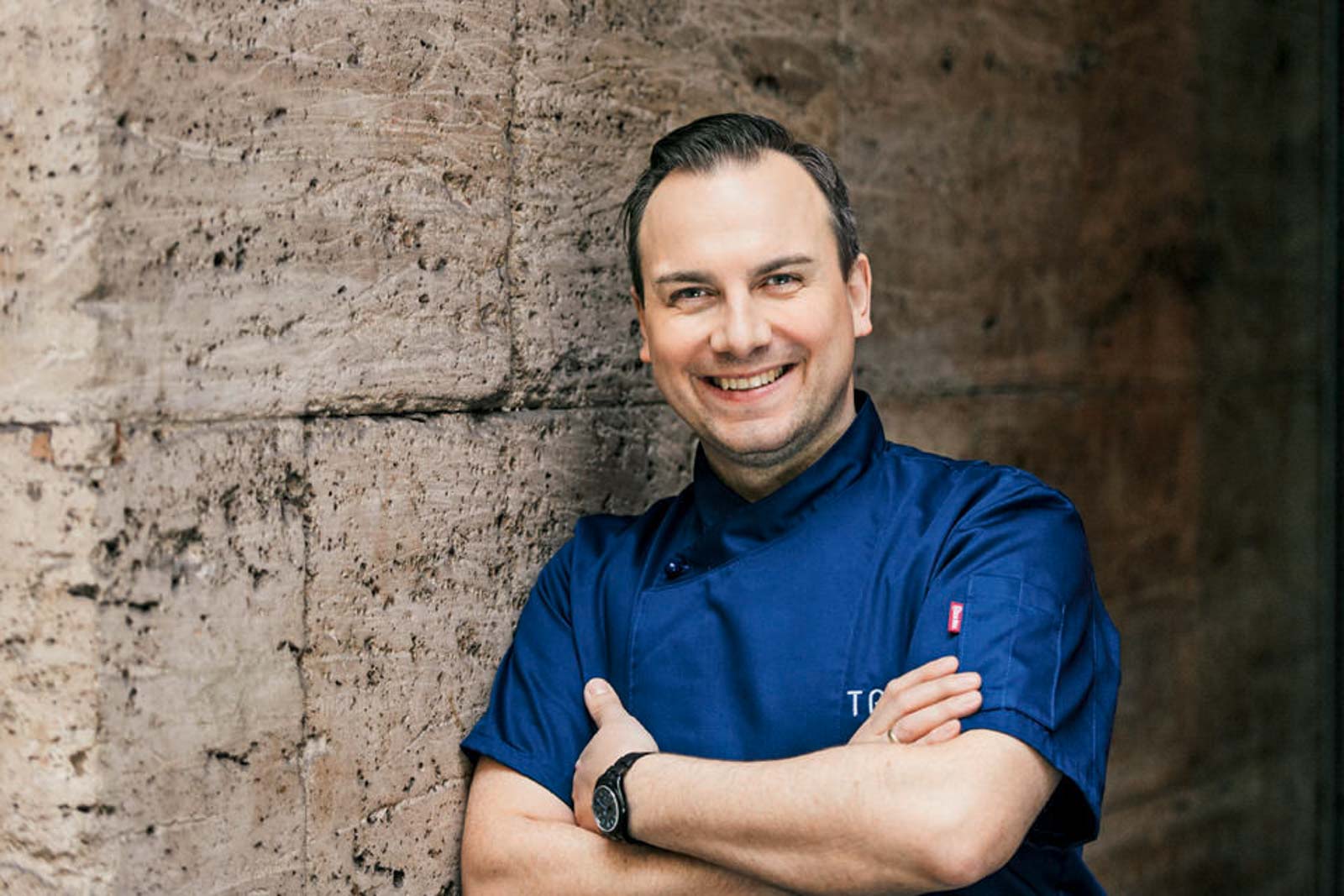Hammering, filing, polishing. This requires patience and a keen instinct. But even more: passion, and this has infected Nicole Hana Kim ever since she created jewelry for the first time in a course. This led to her own label, Hana Kim, for which she produces pieces that not only look pretty, but also score highly in terms of sustainability.
FACES: How did you get into designing jewelry in the first place?
Nicole Hana Kim: I started with a course, just like others take a pottery course or yoga classes. I have always enjoyed the “Nifeli work” and even in the first lesson I was so absorbed that I could hardly wait for the next week. This urge to continue working on pieces until they are finished has remained to this day.
F: When did you know you wanted to start your own label?
NHK: In 2016, I was in Asia for a longer period and decided that I wanted to devote myself fully to jewelry. But I knew very early on that I wanted to make jewelry more intensively. When you discover something that captivates you, it’s very easy to make a decision. Back in Switzerland, I then looked for a part-time job so that I could concentrate fully on jewelry.
F: How do you feel about trends?
NHK: I am not concerned with fashion trends. Trends in a broader sense, such as in materials, for example the trend towards sustainably sourced stones or metals, are important, as this also increases demand from suppliers. This in turn boosts sourcing in the sustainable direction, making it more accessible and affordable. The word “trends” always has a somewhat negative connotation, but when it comes to sustainability, this tendency is extremely important. Today, trends can spread extremely quickly and have a huge impact on such topics.
F: What do your collections have that those from Cartier, Chopard or Tiffany & Co. don’t?
NHK: On the one hand, I am in a price range that is accessible to a much wider audience, and on the other, my pieces have a story. Each piece is made by hand in collaboration with a foundry, which also produces molds by hand in its own workshop. I maintain personal contact with all my suppliers and know that they employ people who have decades of experience in this field. Jewelry is personal, often has a sentimental value and should accompany the wearer for a long time. The fact that the jewelry doesn’t come out of a machine, but has been made by artisans along the entire value chain, is what makes it so magical for me.
F: Your joint collection with Nina Yuun is called “Heimat”. What does this word mean to you?
NHK : I often feel at home when I’m eating or listening to music. Home is something that only exists for me in the past, where I lived as a child, where I felt safe. In particular, my childhood as the daughter of a Korean woman living in Switzerland – the cultural background became visible to me because it represented a contrast to Swiss culture.
F: Why is sustainability so important to you?
NHK: There are many aspects that can be discussed as to what is sustainable or not; of course, sustainability is a continuum and is neither black nor white. But sustainability in the sense of compliance with ecological standards and human rights should be a premise at the beginning of everything these days. This should not be a matter of personal preference, but in my opinion should be regulated by law. If you know that minimum wages, environmental standards or human rights are not respected in the production of products, then this product should not be legally available for purchase.
F: How difficult was it to find sources of sustainably and fairly mined silver and gold?
NHK: The recycled silver was very easy, the biggest refineries in Switzerland offer recycled silver. It becomes more difficult with silver components such as eyelets and chains. What surprised me was the lack of transparency. When you follow up, you get hesitant answers, and then you quickly realize that the desired standards are not being met. I researched gold for a while, met with someone from the Responsible Mining Index and asked Max Havelaar. The difficulty lies in the gilding. There are good alternatives for solid gold, but gold plating is a little more complicated. I now obtain my material from a member of the LBMA. LBMA is an exchange that tests precious metals for purity and sets standards for its partners. The LBMA is one of the largest institutions – some accuse it of having too loose standards, but the LBMA is one of the few, if not the only institution that has the capacity to introduce and control sustainable standards in the gold market. It is important that a discourse takes place, that people look for solutions and do not claim the truth and the golden path for themselves. Recycled silver can also be criticized for coming from dubious sources, but only the end of the value chain is considered. It has to be mined anyway, which means that even recycled silver is not free from criticism.
F: Do you listen to music while you make your jewelry?
NHK: I always listen to podcasts, music rather rarely. I love podcasts and am particularly addicted to knowledge podcasts such as “Stuff you should know” hilariously narrated by the two hosts, “Radiolab” and, more recently, the open conversations about taboo topics by Yvonne Eisenring “Wahrheit, Wein und Eisenring”. When it comes to podcasts, I’m a real nerd.
F: What’s your favorite part of the production process, and which would you rather skip?
NHK: I like working at the workbench, dealing with the material and shaping an idea. The constant interaction between the original idea and the process, which in turn influences the idea, so that in the end something unexpected emerges. Everything has to work together to create something beautiful. Sometimes, when I’m working on a new collection, I’m too conceptual, so I just want to work on the bench and get fed up with the whole design process – when I’m fully in the production phase, I’m content to work on the pieces all the time.
F: What is the best setting to get inspired?
NHK: Definitely outside of everyday life, be it on vacation or in contact with people who are different from me.
F: Can you remember your first piece of jewelry?
NHK : As a child I often went to my aunt’s house, and then one day we went to get my ears pierced, I must have been very young then. The ear studs are the first memory of jewelry I wore.
F: Where do you come up against the limits of sustainability in your everyday life?
NHK: In the packaging of foodstuffs. When things get tough, I quickly buy a sandwich from the store, it’s absurd how much waste is produced.
F: How difficult is it for designers in Switzerland?
NHK: Since I didn’t follow the classic path as a designer, I can’t judge that. At the moment, I have the feeling that there are many open doors and I see many opportunities to move forward.
F: What’s the best advice another designer has given you?
NHK: Success requires staying power. I’m generally a patient person, but I find it difficult when nothing happens for a while. Stepping on the gas for a short time is easy for me, but maintaining consistency over a longer period of time is quite a challenge.
F: What advice would you like to pass on?
NHK: Without coming up with a cheesy phrase, I believe that nowadays, despite a thousand possibilities, people are often guided by fear when making decisions. Risks are avoided out of a sense of security, and I’m not even talking about financial risks, but specifically, as in my case, that you would like to pursue something, but stick to the old familiar out of various fears. And above all, just get started, even if not everything is right.
F: Are you more of a craftswoman or a designer?
NHK: Definitely a craftswoman, I love working at the workbench and I’m particularly fascinated by the manual skills. I notice that even with other jewelry designers, it’s the craftsmen who inspire me and not the conceptual designers.
F: How do you describe Hana Kim?
NHK: Hana Kim is first and foremost jewelry that I like myself. A vessel for me to create and try out new things. Jewelry that claims to be timeless and yet with a surprising design language. As a half-Korean, I also reflect my origins in my jewelry, whether through symbolism or aesthetic elements.
F: Who would you like to see your jewelry on?
NHK: On the next high-flyer artist at the Grammy Awards.
F: You currently sell your collections online and in several concept stores. Would owning your own business be a possible dream?
NHK: Yes, definitely, my studio has almost turned into a store where customers and friends come and go – I would love a nice showroom.
F: In addition to your own jewelry label, you also work as an Illustrator. Isn’t it exhausting having to be creative all the time?
NHK: At the moment I’ve put the illustration stuff on hold and want to concentrate fully on making jewelry. I realize that too much creativity can be exhausting, especially when I’m working on a new collection, but that’s a state of emergency anyway. Otherwise, I see it as a great privilege to be creative day in, day out.
F: Who or what gives you sleepless nights?
NHK: The baby who stays awake all night in the apartment above me. Poor time management is an issue from time to time, but otherwise I’m very relaxed at the moment.
F: When are you happy with yourself?
NHK: Very often, especially with commissioned work, if I can finish a beautiful piece, I’m very happy.
F: What is typical Nicole?
NHK: Eating a croissant in the morning, I love croissants, and everyone in my immediate circle would agree.
F: How can you tell that you’ve grown up?
NHK: I have a 3. pillar, I think that’s very mature.
F: What moment changed everything?
NHK: When I met my studio partner. Finding a job was not that easy. It was this encounter that enabled me to make the decision to work as a jewelry maker in the first place.
F: What are you proud of?
NHK: I quit smoking two years ago, I’m proud of that, it took a few attempts.
F: What annoys you?
NHK: Cynical people annoy me. Old angry citizens who watch racist videos on social media, then give free rein to their hatred in the comments and are still heard.
F: What are you saving for?
NHK: Currently for new material, to finance new collections and otherwise to make new gadgets for jewelry.















